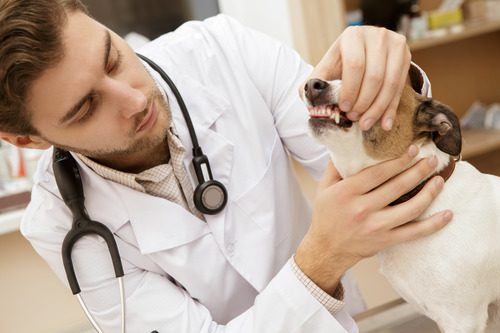Your dog’s gums can reveal more about their health than you might think. A sudden change in gum color—especially if they appear pale—can be one of the first visible signs that something isn’t right. While it might not seem urgent at first glance, pale gums in dogs can point to serious underlying issues that require prompt attention. In this blog, we’ll explain what pale gums can mean, what causes them, and why it’s important to contact your veterinarian if you notice this change. If you’re concerned about your dog’s gum color, this article will help you understand what to look for and when to reach out to our team at Millis Animal Hospital.

What Do Pale Gums in Dogs Look Like?
Healthy dog gums typically appear pink and moist. Pale gums, on the other hand, may look white, gray, or very light pink. This discoloration can be uniform or patchy and is most noticeable when you gently lift your dog’s lip to examine their mouth. It’s a good idea to become familiar with your dog’s normal gum color so you can more easily recognize any changes. Keep in mind that lighting, your dog’s natural pigmentation, and hydration levels can influence how their gums appear.
How to Check Your Dog’s Gums
To examine your dog’s gums safely:
- Gently lift the lip while your dog is calm.
- Look at the color of the tissue above the teeth.
- Press a finger gently against the gum, then release to perform a capillary refill test. The spot should return to pink within 1–2 seconds.
If the gums stay pale or refill very slowly, it’s time to contact your veterinarian.
What Are My Dog’s Gum Pale?
Pale gums in dogs can indicate a wide range of underlying issues. Some causes are minor, while others require urgent medical attention. Below are several potential reasons for this symptom.
Anemia
Anemia occurs when your dog’s body lacks enough red blood cells to carry oxygen effectively. This can be caused by:
- Internal or external bleeding
- Chronic illness
- Immune-mediated diseases
- Parasitic infections (such as fleas, ticks, or hookworms)
Anemic dogs may also show signs of lethargy, weakness, and decreased appetite.
Blood Loss
Acute or chronic blood loss—either from trauma, internal bleeding, or surgical complications—can quickly lead to pale gums. Even if you don’t see external bleeding, internal issues like a ruptured tumor or bleeding ulcers may be responsible.
Shock
Shock reduces circulation, which in turn can cause pale gums. It can occur due to:
- Severe allergic reactions
- Heatstroke
- Trauma
- Severe dehydration
Dogs in shock often appear weak, have a rapid heart rate, and may collapse. Immediate veterinary intervention is critical.
Heart Disease
When the heart isn’t pumping blood efficiently, oxygen delivery throughout the body—including to the gums—can suffer. Pale gums may appear alongside coughing, shortness of breath, or fainting episodes.
Kidney or Liver Disease
Advanced disease affecting the kidneys or liver can impair circulation and blood cell production, leading to pale or yellow-tinged gums. Other signs might include vomiting, increased thirst, or changes in urination.
Parasites
Heavy infestations of blood-sucking parasites such as fleas or ticks can cause anemia, especially in puppies or small breeds. Hookworms, which live in the intestinal tract, can also lead to blood loss.
When Is It Time to Seek Veterinary Care?
If you notice pale gums in your dog, it’s important not to delay care. While some causes may be mild, others can progress quickly without treatment. Contact your veterinarian right away if pale gums appear alongside any of the following:
- Lethargy or weakness
- Rapid breathing or panting
- Vomiting or diarrhea
- Loss of appetite
- Collapse or unresponsiveness
- Visible wounds or bleeding
Millis Animal Hospital offers diagnostic services to determine what’s causing pale gums in dogs. This may include blood work, X-rays, ultrasounds, and other assessments to guide treatment.
How Veterinarians Diagnose the Cause of Pale Gums in Dogs
Identifying the reason behind pale gums starts with a thorough physical exam. Your veterinarian will check vital signs, examine gum color and hydration levels, and ask about your dog’s medical history and recent behavior.
Diagnostic Tools Often Used:
- Complete blood count (CBC): Evaluates red blood cell levels and can detect anemia or infection.
- Blood chemistry panel: Assesses organ function, including liver and kidneys.
- Fecal testing: Checks for internal parasites like hookworms.
- X-rays or ultrasound: Helps visualize internal organs, bleeding, or masses.
- Urinalysis: Gives insight into kidney health and hydration status.
What Are Potential Treatment Options for Dogs with Pale Gums?
The treatment for pale gums in dogs depends entirely on the underlying condition. Once the cause has been identified, your veterinarian will develop a treatment plan tailored to your dog’s needs.
Examples of Treatment Approaches:
- Anemia: May be treated with iron supplements, medications, or blood transfusions in severe cases.
- Internal bleeding: Often requires surgery or emergency stabilization.
- Parasites: Deworming medications and parasite prevention can resolve infestations.
- Dehydration or shock: Treated with IV fluids, oxygen therapy, and supportive care.
- Organ disease: Managed with medications, dietary changes, and ongoing monitoring.
Your veterinarian will provide guidance on what your dog needs and how to support their recovery at home.
Can Pale Gums Be Prevented?
While you can’t always prevent the underlying conditions that cause pale gums in dogs, there are steps you can take to reduce the risk.
- Keep your dog on a year-round parasite prevention plan.
- Schedule regular wellness exams and blood work to catch issues early.
- Feed a balanced diet and maintain a healthy weight.
- Monitor your dog for signs of illness or unusual behavior.
- Avoid exposure to toxins or dangerous foods.
Pale gums in dogs can be a sign of an underlying medical issue that shouldn’t be overlooked. While it may seem like a minor change, it often points to a larger problem affecting your dog’s circulation, red blood cells, or internal organs. The sooner you identify the cause, the better your dog’s chance of a smooth recovery. If you notice pale gums in your dog, call Millis Animal Hospital at 508-376-5317 or request an appointment online. Our team is here to help protect your dog’s health and peace of mind.
Recent Posts
About Us
Millis Animal Hospital is a privately owned AAHA-accredited, Cat-Friendly Certified practice staffed with Fear Free Certified professionals. We know a thing or two about treating pets and their families the way they deserve, with excellent preventive care and surgical services tailored to your individual needs.
